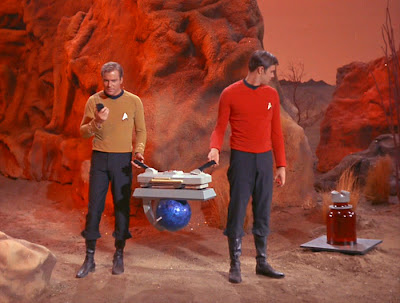McCoy briefs Kirk and the other members of the landing party about the Capellans, who McCoy studied years before his posting to the Enterprise. Kirk's mission is clear: secure Capella IV from forming an alliance with the Klingon Empire. All chaos breaks loose when Kirk disregards McCoy's warnings about interfering with the strict traditions of the Capellans and prevents the killing of Eleen, the pregnant wife of the deposed High Teer, Akaar. Kras, a Klingon trying to secure relations with the Capellans for the Klingon Empire, makes the best of the situation, leading to the landing party and Eleen becoming hunted criminals. Meanwhile, Scotty, in temporary command of the Enterprise, plays a game of cat and mouse with a mysterious vessel, which Scotty deduces is a Klingon scout vessel. McCoy delivers Eleen's unwanted baby while Kirk and Spock prepare to wage war against the Capellans with homemade bows and arrows. Kras kills the current Teer, and the Capellans kill Kras. Eleen has a change of heart and keeps her baby boy, who she names "Leonard James Akaar," who is named the new ruler. Kirk and crew leave Capella with relations secured with the Capellans and a proud Kirk and McCoy enjoying the fact that they have a boy named after them.
Story
This was my first time seeing "Friday's Child," and I was amazed by this episode. It's got everything from comedy, drama, and action. I was amazed how well this story works on all levels, and how it succeeds in giving all the cast members something to do. This episode is clearly a template for all the best Trek episodes that give the entire cast memorable roles and scenes. Its influence can be seen in the final four films to feature the original cast, which all balanced action and drama while featuring the entire cast in action critical to the story.
Action
There's action aplenty here in "Friday's Child." There's a great fight between the landing party and the Capellans at the beginning, Scotty's investigation of the distress call and his chase with the scout ship, and the final battle with the Capellans at the end.
Performances
Everyone shines here, especially the Big Three, who are all clearly loving the hell out of the material they've been given. Of special note is Julie Newmar's performance as Eleen, best known in the States as "Catwoman" in the "Batman" TV series which was a contemporary of Star Trek. She's spirited and beautiful, a typical Star Trek woman. I apologize beforehand, but "Meeoow!"
Trektastic Moments
I was telling my wife just how awesome this episode is in the Trektastic Moments department. She just nodded, but man, this one's got it all, folks. There's lively, classic banter between Kirk, Spock, and McCoy. I laughed out loud numerous times. In one scene, Kirk, Spock, and McCoy are bringing Eleen up the mountain to the safety of a nearby cave. Eleen only respects McCoy and won't let anyone else touch her, and McCoy laments, "I need some help here. I'm a doctor, not an escalator!" Following that is a scene wherein Kirk and Spock are making bows and arrows in the absence of their hand phasers. Spock comments to Kirk: "Fortunately, this tree bark has sufficient tensile cohesion." To which Kirk replies: "So you mean they'll make good bowstrings." To which Spock replies: "Is that not what I just said?" This is just classic, great stuff, courtesy of legendary Trek write D.C. Fontana.
One of my other favorite scenes occurs towards the end when McCoy is holding Eleen's son. It goes a little something like this:
McCoy: (to baby): "Oochie woochie coochie coo? Oochie woochie coochie coo!"
Spock: (to Kirk): "'Oochie woochie coochie coo,' Captain?"
Kirk: "Yes, 'oochie woochie coochie coo. An obscure Earth dialect. If you're curious, consult lignuistics."
That's solid gold dialogue right there, kids. There's nothing as inspired and warm as that on TV today and there likely won't be, outside of maybe Joss Whedon and J.J. Abrams, and even then, it's still not Fontana. Beautiful.
There's also the great little Chekov moment on the Enterprise during the pursuit of the Klingon vessel, wherein Pavel takes credit for a common saying, attributing to his Russian heritage. And lest I forget, the episode features a Redshirt death early on in the show! This episode is now one of my all-time Trek favorites due to the excellent writing and performances which mark it as truly classic Trek.
Overall
What more could you want? There's drama, tension, action, excitement, peril, and even comedy. Classic Trek in the mold of that which makes Trek what it is. Highest possible recommendation.
The episode's title card.

Dun dun dun, another Redshirt bites the dust!

The extremely sexy Julie Newmar. Wowzers. No wonder she was Catwoman!

"I'm a doctor, not an escalator!"

Kirk explains the obscure Earth dialect known as "oochie woochie coochie coo" to Mr. Spock.





















































